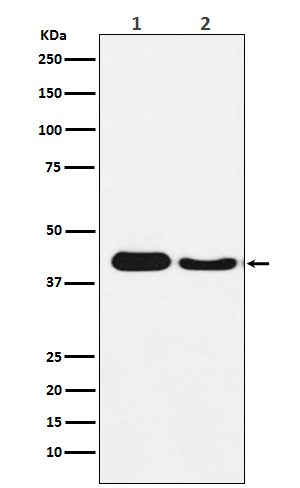Atg4A Antibody
Rabbit mAb
- 产品详情
- 实验流程
Application
| WB, IHC, IP |
|---|---|
| Primary Accession | Q8WYN0 |
| Reactivity | Rat, Human, Mouse |
| Clonality | Monoclonal |
| Other Names | Apg4a; ATG4A; Atg4al; AUT like 2 cysteine endopeptidase; Autl2; Autophagin 2; Autophagin-2; Autophagy related 4A cysteine peptidase; |
| Isotype | Rabbit IgG |
| Host | Rabbit |
| Calculated MW | 45378 Da |
| Dilution | WB 1:500~1:2000 IHC 1:50~1:200 IP 1:50 |
|---|---|
| Purification | Affinity-chromatography |
| Immunogen | A synthesized peptide derived from human Atg4A |
| Description | The cysteine protease Atg4 is pivotal to autophagosome membrane generation and regulation. Atg4 primes the Atg8 homologue for lipidation by cleaving its carboxy terminus and exposing its glycine residue for E1-like enzyme Atg7. The Atg8 homologue is transferred to the E2-like enzyme Atg3 before forming the Atg8-PE conjugate. During later stages of autophagy, Atg4 can reverse this lipidation event by cleaving PE, thereby recycling the Atg8 homologue. |
| Storage Condition and Buffer | Rabbit IgG in phosphate buffered saline , pH 7.4, 150mM NaCl, 0.02% sodium azide and 50% glycerol. Store at +4°C short term. Store at -20°C long term. Avoid freeze / thaw cycle. |
| Name | ATG4A {ECO:0000303|Ref.20, ECO:0000312|HGNC:HGNC:16489} |
|---|---|
| Function | Cysteine protease that plays a key role in autophagy by mediating both proteolytic activation and delipidation of ATG8 family proteins (PubMed:12473658, PubMed:15169837, PubMed:17347651, PubMed:21177865, PubMed:21245471, PubMed:22302004, PubMed:32732290). The protease activity is required for proteolytic activation of ATG8 family proteins: cleaves the C-terminal amino acid of ATG8 proteins to reveal a C-terminal glycine (PubMed:12473658, PubMed:15169837, PubMed:17347651, PubMed:21177865, PubMed:21245471, PubMed:22302004). Exposure of the glycine at the C-terminus is essential for ATG8 proteins conjugation to phosphatidylethanolamine (PE) and insertion to membranes, which is necessary for autophagy (PubMed:12473658, PubMed:15169837, PubMed:17347651, PubMed:21177865, PubMed:21245471, PubMed:22302004). Preferred substrate is GABARAPL2 followed by MAP1LC3A and GABARAP (PubMed:12473658, PubMed:15169837, PubMed:17347651, PubMed:21177865, PubMed:21245471, PubMed:22302004). Protease activity is also required to counteract formation of high-molecular weight conjugates of ATG8 proteins (ATG8ylation): acts as a deubiquitinating- like enzyme that removes ATG8 conjugated to other proteins, such as ATG3 (PubMed:31315929, PubMed:33773106). In addition to the protease activity, also mediates delipidation of ATG8 family proteins (PubMed:29458288, PubMed:33909989). Catalyzes delipidation of PE- conjugated forms of ATG8 proteins during macroautophagy (PubMed:29458288, PubMed:33909989). Compared to ATG4B, the major protein for proteolytic activation of ATG8 proteins, shows weaker ability to cleave the C-terminal amino acid of ATG8 proteins, while it displays stronger delipidation activity (PubMed:29458288). Involved in phagophore growth during mitophagy independently of its protease activity and of ATG8 proteins: acts by regulating ATG9A trafficking to mitochondria and promoting phagophore-endoplasmic reticulum contacts during the lipid transfer phase of mitophagy (PubMed:33773106). |
| Cellular Location | Cytoplasm {ECO:0000250|UniProtKB:Q8BGE6}. |
Research Areas
For Research Use Only. Not For Use In Diagnostic Procedures.
Application Protocols
Provided below are standard protocols that you may find useful for product applications.
终于等到您。ABCEPTA(百远生物)抗体产品。
点击下方“我要评价 ”按钮提交您的反馈信息,您的反馈和评价是我们最宝贵的财富之一,
我们将在1-3个工作日内处理您的反馈信息。
如有疑问,联系:0512-88856768 tech-china@abcepta.com.
¥ 1,500.00
Cat# AP91481























 癌症的基本特征包括细胞增殖、血管生成、迁移、凋亡逃避机制和细胞永生等。找到癌症发生过程中这些通路的关键标记物和对应的抗体用于检测至关重要。
癌症的基本特征包括细胞增殖、血管生成、迁移、凋亡逃避机制和细胞永生等。找到癌症发生过程中这些通路的关键标记物和对应的抗体用于检测至关重要。 为您推荐一个泛素化位点预测神器——泛素化分析工具,可以为您的蛋白的泛素化位点作出预测和评分。
为您推荐一个泛素化位点预测神器——泛素化分析工具,可以为您的蛋白的泛素化位点作出预测和评分。 细胞自噬受体图形绘图工具为你的蛋白的细胞受体结合位点作出预测和评分,识别结合到自噬通路中的蛋白是非常重要的,便于让我们理解自噬在正常生理、病理过程中的作用,如发育、细胞分化、神经退化性疾病、压力条件下、感染和癌症。
细胞自噬受体图形绘图工具为你的蛋白的细胞受体结合位点作出预测和评分,识别结合到自噬通路中的蛋白是非常重要的,便于让我们理解自噬在正常生理、病理过程中的作用,如发育、细胞分化、神经退化性疾病、压力条件下、感染和癌症。






